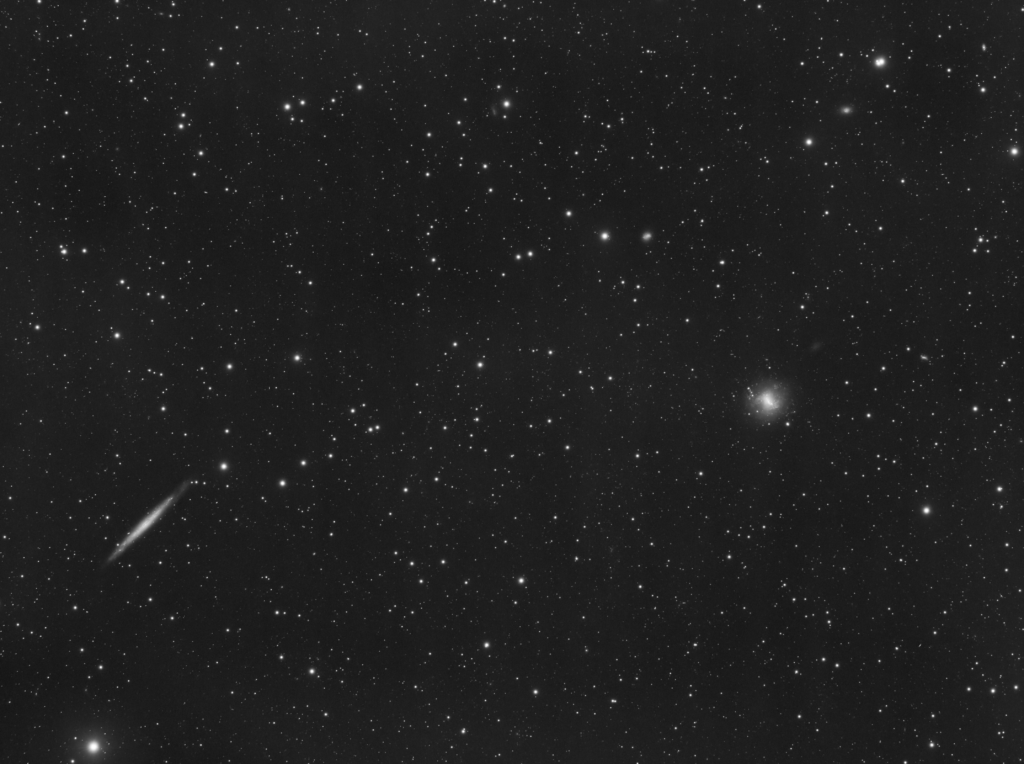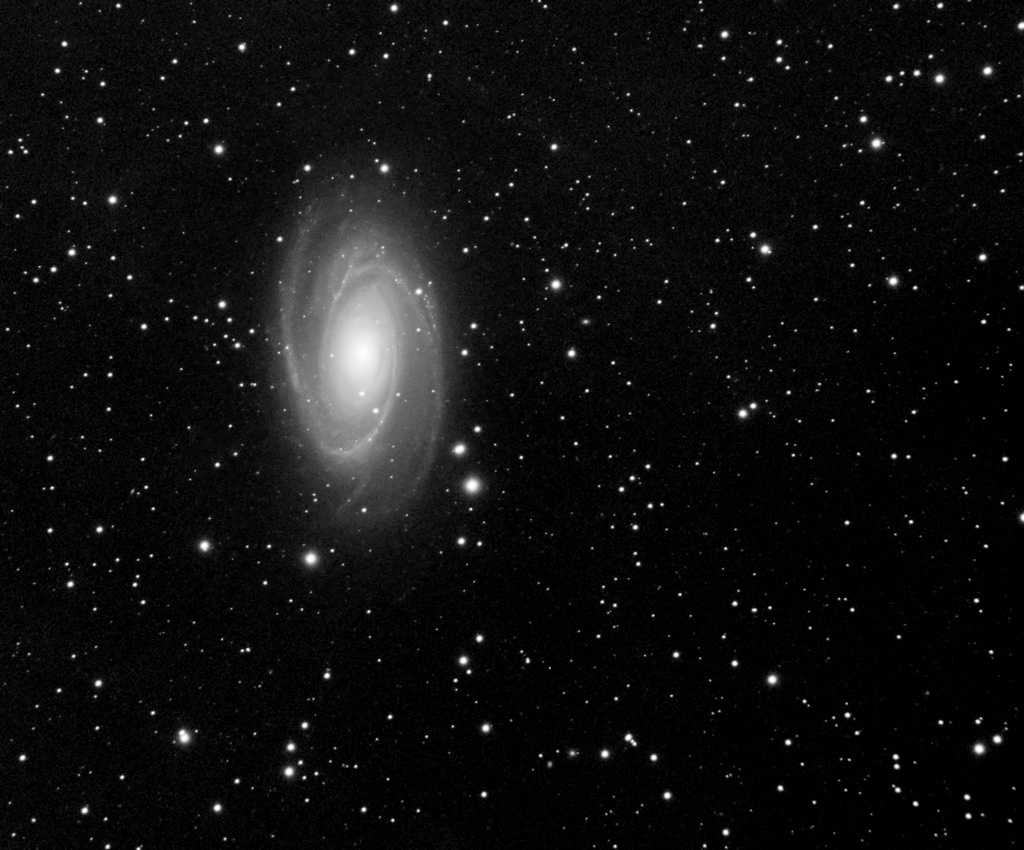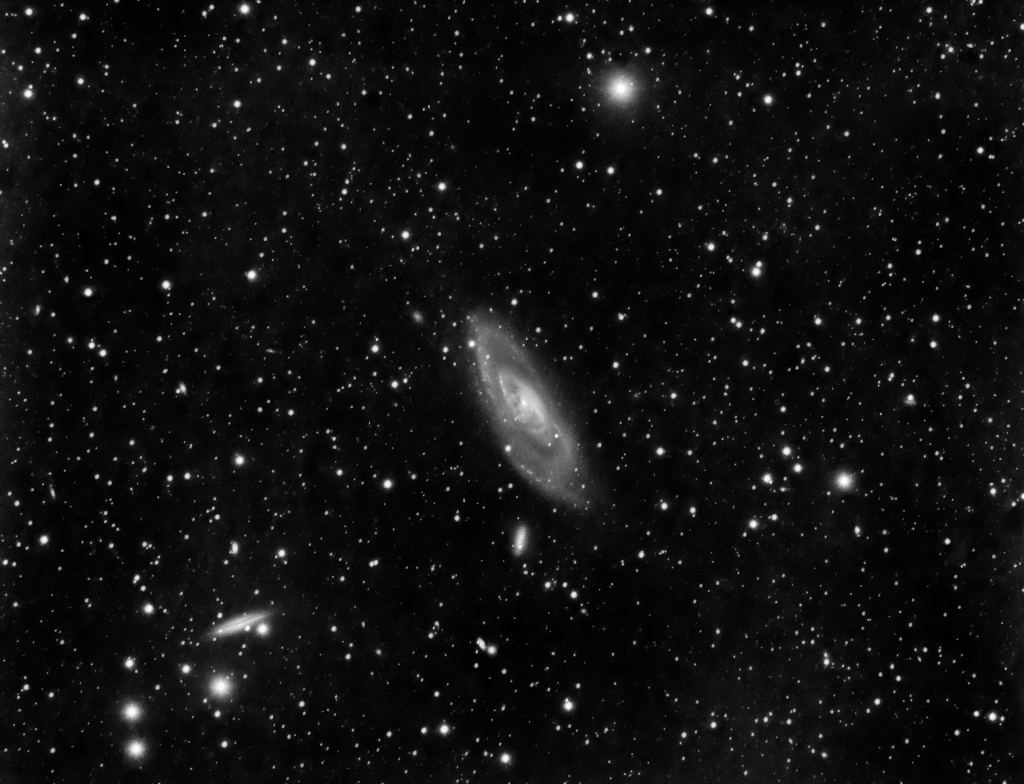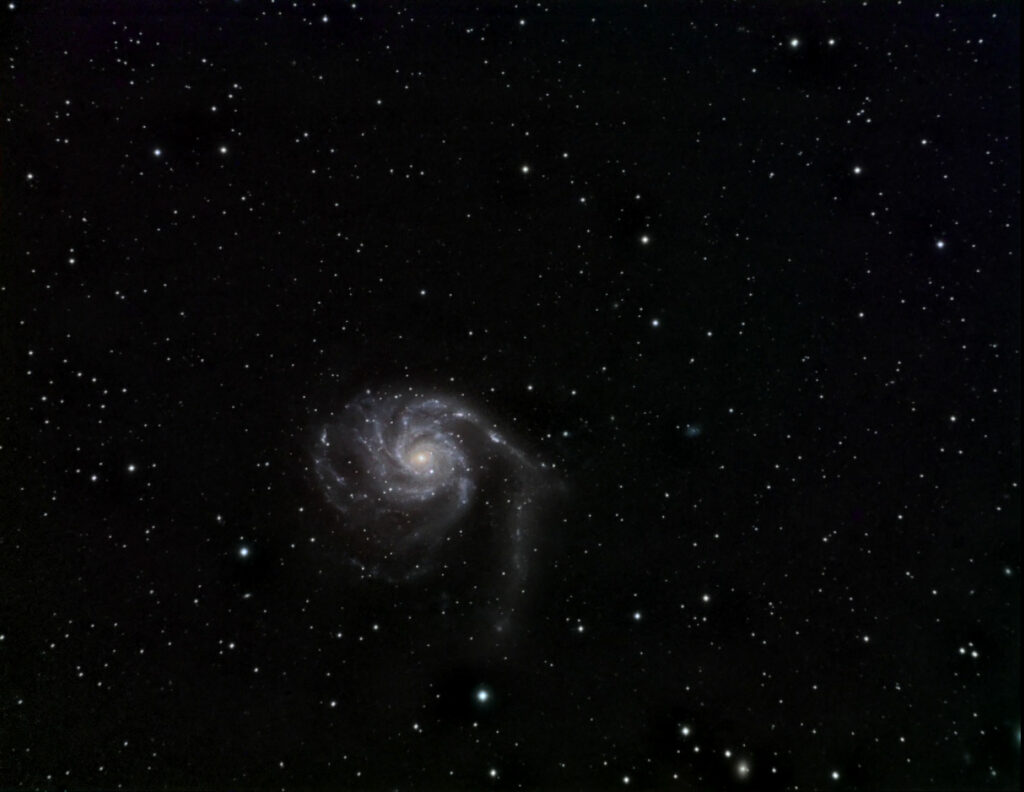Galaxy NGC4244 and NGC4214
| Scope: | TMB 80mm APO Refractor at f/4.8 |
| Camera: | ZWO ASI 1600MM Pro |
| Mount: | iOptron CEM120EC |
| Filters: | None |
| Exposure: | 180 x 60sec light frames Darks and flats applied. |
| Processing: | A stack of 163 x 60sec frames using Pixinsight’s fast batch processing, which reduces calibration times by a massive margin. For screen images produced at small pixel sizes, any reduction in quality is never going to be noticeable. All I’ve done to the image is a tweek from the std STF stretch and a round of BXT and BlurXterminator. |
| Other Comments | I no longer bother with guiding anymore. The encoder on the RA axis tracks well enough without any external interference. |
| Date Taken: | 14/05/2020 |
Galaxy NGC 3031 (M81)
| Scope: | TMB 80mm APO Refractor at f/6 |
| Camera: | ZWO ASI 1600MM Pro |
| Mount: | Losmandy G11 – Gemini Series IV GoTo |
| Filters: | None |
| Exposure: | 73 x 60sec light frames Dark subtracted, No Flats. |
| Processing: | |
| Other Comments | A total of 73 x 60sec light frames which have been dark subtracted. I wasn’t really worried how this turned out as this session was more of a test of how PHD was performing. Not having used PHD before, I was generally playing around with the various settings to see how they would affect the guiding error rates. |
| Date Taken: | 23/03/2020 |
Galaxy NGC 244 (M31)
| Scope: | Takahashi FSQ-ED 106 f/5 |
| Camera: | SBIG STL-11000 |
| Mount: | Paramount PME |
| Filters: | LRGB |
| Exposure: | 11 x 300sec Bin 1×1, 5 x 300 sec in the Blue, 9 x 180 sec in the Green and 7 x 300 sec in the Red RGB all 2×2 bin. Dark Subtracted, Flat fielded |
| Processing: | I finally managed to get a good spell of clear weather in New Mexico. M31 is such a popular target for imagers and we see so many images of it, but it really does suit this scope and camera combination. I also wanted to practice my processing skills in Pixinsight, especially as colour is not something I have done much of. |
| Other Comments | Overall I’m happy with this. The core shows nice graduation and the outer star forming regions show good detail. As for the colour – I haven’t tweaked this too much. I used Pixinsights star colour calibration tool so didn’t want to stray from what this gave me. |
| Date Taken: | 09/12/2018 |
Galaxy NGC 4258 (M106)
| Scope: | TMB 80 f/4.8 |
| Camera: | SBIG 2000 XM |
| Mount: | Losmandy G11 – Gemini Series IV GoTo |
| Filters: | None |
| Exposure: | 23 x 10 min Bin 1×1 0c Dark Subtracted, No Flats |
| Processing: | All combined, calibrated and stacked in Pixinsight 1.08. DBE followed by ABE. Then,quite a bit of Multi Scale Linear Transformation to reduce the noise, followed by a full stretch.Then given a HDR Multi scale Transform to bring out some of the detail in the spiral arms, before loading the image into Affinity Pro for a final tweak and a High Pass sharpen. |
| Other Comments | Trawling through 11 year old archives, to give a newly acquired copy of Pixinsight 1.08 a run to see what it could do. This series of images was originally rejected because of the noise, not to mention the terrible seeing. But 10 years worth of software technology improvement has resurrected this image to within acceptable limits. I’m sure that more practice with the software could improve this even more. |
| Date Taken: |
Bode’s Nebula NGC 3031 & NGC 3034
| Scope: | TMB 80mm APO Refractor at f/4 |
| Camera: | SBIG 2000 XM |
| Mount: | Losmandy G11 – Gemini Series IV GoTo |
| Filters: | None |
| Exposure: | 12 x 5 min Bin 1×1 10c Dark Subtracted, No Flats |
| Processing: | With only 60 minutes of luminance, the data is a little thin. A couple of iterations of curves with the cores of both galaxies being held back to prevent saturation. Guiding was spot on, so no work has been done on the stars. The galaxies were then given one round of curve adjustment to bring out the faint detail in the outer fringes. The brighter areas were then given a mild unsharp mask. The background areas were smoothed using Neat Image. |
| Other Comments | The first image of 2007. In order to get colour for this, I limited Luminance to 60 mins, and then managed to get 45 mins of RGB data. This will be added later. |
| Date Taken: | 09/03/2007 |
Galaxy NGC 5457 (M101) in Ursa Major
| Scope: | TMB 80mm APO Refractor at f/6 |
| Camera: | SBIG 2000 XM |
| Mount: | Losmandy G11 – Gemini Series III GoTo |
| Filters: | SBIG CFW8 RGB |
| Exposure: | Luminance 18 x 10 min Bin 1×1 RGB 8 x 5 min for each of the RGB channels, which are Binned 2×2. -20c dark subtracted, No Flat |
| Processing: | Acquisition Maxim DL 4.51, Photoshop CS2. Russell Croman’s GradientXterminator removed a nasty light leak gradient. A couple of iterations of curves and black point adjustment was followed by selective curve adjustment of the brighter areas. Sharpening the high S/N areas and smoothing on the background with dust mote removal was followed by some mild star reduction using the minimum filter. |
| Other Comments | The luminance component this image was taken from the previous image below. This was combined with RGB components taken a month later. Apart from histogram stretching to equalise the colour channels at both ends (something I never tried before), I didn’t radically alter the colour balance. I set the core colour and let the rest take care of itself. A lot of images of M101 seem far too saturated, and so I have tried to fiddle with the colour as little as possible. This the first LRGB image that I’m really happy with. |
| Date Taken: | 03/04/2006 |





